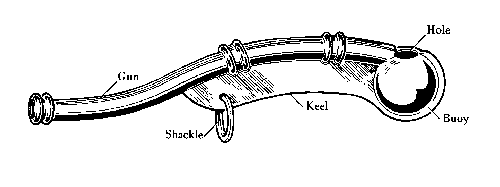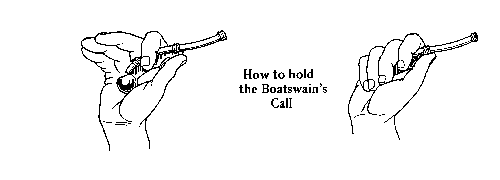Boatswain's Call Tutorial
History of the Boatswain's Call (Bosun's Call)
The Boatswain's Call,or whistle, was once the only method other than the human voice of passing orders to men on board ship. Today more sophisticated communications systems exist but the Royal Navy, always believers in tradition, still use the Boatswain's Call as a mark of respect to pipe the Captain or special visitors on board, or for emphasising important orders. The boatswain was the officer in charge of rigging, sails and sailing equipment. He therefore needed to issue orders more often than other officers and so the whistle was named after him. In the old days men were rigidly trained, almost like sheepdogs, to respond immediately to the piping of the Call. At sea, in moments of danger - particularly in storms - they could be counted on to hear the high-pitched tones of the Call, and react without delay. A shouted order may not have been heard above the sound of howling winds and lashing waves. Instructions to hoist sails, haul or let go ropes were conveyed by different notes and pitches. It is known that the galley slaves of Rome and Greece kept stroke to the sound of a flute or whistle similar to the Boatswain's Call. It was first used on English ships in the thirteenth century, during the crusades, and became known as "The Call" about 1670 when the Lord High Admiral of the Navy wore a gold whistle as a badge of rank. This was known as the "Whistle of Honour." The ordinary whistle of command was issued in silver and often each officer had his own Call decorated with rope designs and ship's anchors. Each section of the Boatswain's Call has a nautical name. The ball is the buoy; the mouthpiece is the gun; the ring is called the shackle and the leaf is called the keel.

Using the Boatswain's Call
The call should be held between the index finger and thumb, with the thumb on or near the shackle The side of the buoy rests against the palm of the hand and the fingers close over the gun and buoy hole in position to throttle the exit of air from the buoy to the desired amount. Care should be taken not to touch the hole of the buoy or the end of the gun, or the sound will be choked. There are two main notes, the "low" and the "high" and there are three tones, the "plain" the "warble" and the "trill". The plain note is made by blowing steadily into the mouth of the gun with the hole of the buoy unobstructed by the fingers. The plain high note is produced by partly throttling the exit of air from the buoy. This is done by wrapping the fingers round the buoy, taking care not to touch the edges of the hole. Intermediate notes can be obtained by throttling to a greater or lesser degree. The warble is obtained by blowing in a series of jerks, with a result like the call of a canary. The trill is produced by vibrating the tongue while blowing, as if rolling the letter "R". The Call can be tuned by scraping away and enlarging the wind edge of the hole in the buoy until it will sound if the mouth of the gun is held directly into a moderate wind.

Piping the side as a mark of respect
The best known use of the Boatswain's Call is for "Piping the Side", the signal of respect which, in the Royal Navy, is reserved for the Sovereign, senior Royal Navy officers and for all foreign naval officers. A corpse when being brought on board or sent out of a ship is also piped, but the Side is never piped at any shore establishment. This mark of respect owes its origins to the days when captains used to visit other ships when at sea. On such occasions the visiting captain was hoisted aboard from his boat in a chair slung on a whip rope from the lower yard-arm, to the accompaniment of the pipe of the boatswain giving orders to the men manning the whip.